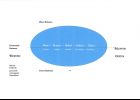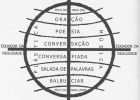A dimensão da escrita em Vilém Flusser e Guimarães Rosa
Vilém Flusser wrote about the Brazilian modernist author João Guimarães Rosa (1908-1967) who he met personally. Although most of Guimarães Rosa’s work had been written before their meeting, Flusser’s thinking might have influenced his writing. In 1961, Guimarães Rosa published the short story Fita verde no cabelo and Flusser wrote an article about it. Both texts were published the same year in the Literary Supplement of O Estado de São Paulo. The essay focuses on questions of style as well as on the cultural and etymological references of the two writers.
Im Spielraum der Ironie. Wie Vilém Flusser über Design schrieb
Flusser’s writings on design are mainly characterized by an essayistic and ironic style. In my text, I highlight Flusser’s use of these two styles, since he considered that the conventional approaches of established discourses could not adequately address the existing realities, and their complexities. For Flusser, essays are phenomenological narrations concerned with arbitrary objects, in which the distinction between common and high culture becomes blurred. That explains why his writings on design and ethics, or on design and war, are described as being difficult to access, and are even provocative. But it is not only the content of Flusser’s essays that provokes. His ironic and parodist style of writing is used to make a caricature of the complacency of the design debates of his time, and to point to the evasive question of responsibility in design. He noted that ethical issues were never raised in relation to the designed objects, and thus he portrayed the design of common or mundane objects as being irresponsible, given that designers focused their attention solely on the object, rather than on the people who use it, or on the cultural contexts in which they were used. Accordingly, Flusser identified design as a tool by which culture betrayed itself. To emphasize this point, he employed images and exaggerations in his essays, which he called “karikaturale Vereinfachungen.” Flusser uses an elaborate etymological juggling of words and caricatures, which is key to his writings on design. I argue that without his etymological caricatures and the irony in his writings, Flusser could not have expressed his philosophy of design with precision.
Writing Philosophy. On Vilém Flusser’s Multilingual Dialogical Style
Flusser’s brilliant multilingual essayistic style is not only based on his practice of constant translation and retranslation. In his texts, he also makes frequent use of challenging metaphors, and even annoying comparisons, through an array of rhetorical devices including, etymologies, puns based on homophones (paronomasia), and polysemy, in order to draw the reader’s attention to the fundamental constructed ways of our looking at the world. His philosophical rhetoric of breaking up, multiplying, mixing, comparing, combining, linking and connecting is a strategy used to create novelty and surprise, that is, new information through recombination. Flusser’s philosophy operates on a meta-communicative level: language is a model, a network that captures meaning, given that all languages are artificial, and words do not primarily mean objects but other words of the same language or different languages. Languages are not primarily representational but interconnected systems of signs. Flusser calls our attention to the material side of the medium he is using, to the diversified opacity of the different languages he writes with. In sum, Flusser wants to achieve these different goals by having us embark with him as dialogical partners on an ironical journey.
„Ich habe gegen Pathos zu kämpfen gehabt […].“ Zur Entstehung und Bedeutung von Vilém Flussers Das Zwanzigste Jahrhundert. Versuch einer subjektiven Synthese
This essay deals with Vilém Flusser’s first finished, but still unpublished book Das Zwanzigste Jahrhundert, which was most probably written in the mid-1950s. The book consists of six chapters linked to each other in an unfolding spiral: politics, society, science, art, philosophy and religion. Flusser’s main aim is to try to synthesize the West with the East: modern Western science with the Indian philosophy of the Vedanta, the contemporary Western concept of art with that of Chinese culture and the Judaic-Christian belief with Hinduism and Buddhism. This synthesis is possible because the West and the East have been slowly evolving in the same direction. The book is remarkable both from a thematic and a stylistic point of view. It is the very origin, and construction site of Flusser’s work to come. Flusser has discarded some of the ideas put forward in Das Zwanzigste Jahrhundert, but retained many others transforming them over the course of the years. Furthermore, Das Zwanzigste Jahrhundert allows a reflection on the origins of Flusser’s writing, and on the development of his style.


